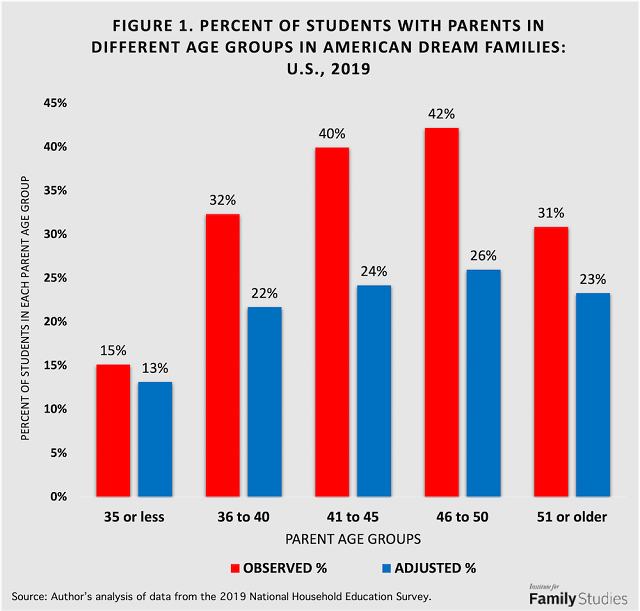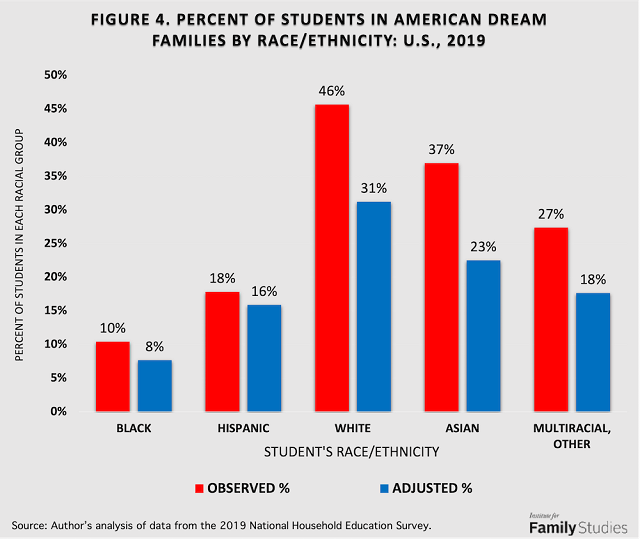Highlights
- 64% of all school-aged children live in homes that their parents own or are buying; 57% are being raised by married-birth parents; 51% live in households with income above $75,000. Post This
- Only 32% of school-aged children are growing up with married birth parents who are home owners and earn $75,000 or more a year. Post This
- Children in American Dream families tend to have both parents working. Post This
The traditional life path for young adults in the United States was to finish school, get a job, find a suitable mate, get married, and earn and save enough to hopefully buy a house. Then have children and raise them together in that home. There were many economic and emotional rewards that accrued to those who followed this so-called “success sequence,” not only to the women and men themselves, but also to their children and the communities in which they resided and the schools their children attended. But social and economic changes have conspired to make it harder to carry out this traditional “American Dream” life plan.
There are many impediments, ranging from globalization and automation, to increases in professional/technical jobs, to changes in societal attitudes regarding marriage and family that have led to the postponement of family formation.1 How many of today’s children are being raised by parents who managed to surmount these obstacles and carry out the American Dream life path? Who are they? Where are they? How do their parents manage to achieve above average incomes, home ownership, and parenthood?
To answer these questions, I made use of data from the 2019 National Household Education Survey. This is a periodic cross-sectional survey of parents of school-aged-children in elementary and secondary schools throughout the country. I defined the target group by the following criteria:
- Students who were living with both their biological parents.
- Parents were married.
- Parents’ joint annual income was $75,000 or more, or at least slightly higher than average. (The median household income in 2019 was $68,703.)
- Parents owned or were buying their home as opposed to renting or living in it free.
Students in American Dream Families
How many students live in American Dream families? My analysis showed that:
- 64% of all school-aged children live in homes that their parents own or are buying.
- 57% are being raised by married-birth parents.
- 51% live in households with a total household income above $75,000.
The proportion meeting all three of these criteria is 32 percent, amounting to 17 million out of the 53.1 million children in elementary, middle, or high schools in the U.S. in 2019.2
A closer look at the characteristics of these children living in American Dream families reveals the following facts:
- Most have middle-aged or older parents: 90% have parents who are age 36 or older. Only 10% have parents who are 35 or younger.
- Their parents tend to be college graduates. More than three-quarters of parents have at least a college degree and 38% have a professional or postgraduate degree. Only 7% have only a high school diploma or less.
- Most of their parents work full time: 75% have both parents employed and 45% have both parents working full time year-round.
- Most are White: 69% are white and 14% are Hispanic. Only 4% are Black.
- Many are the children of first-generation immigrants: 23% have parents where one or both were born in another country; 12% have two foreign-born parents.
Where Do They Live?
Children whose parents are living the American Dream live in all regions of the country. The largest proportion (34%) resides in the South, but only because that is where more of all children are. The smallest proportion lives in the Northeast (19%), again because that is where the smallest proportion of all children live. Children in the Northeast and Midwest have a greater likelihood of being in an American Dream family than those in the South and West. Additionally:
- 60% reside in large suburbs and towns and rural areas on the fringes of large metropolitan areas. Less than 13% live in large cities.
- 60% reside in Zip Code Areas where less than 5% of families have children below the poverty line. Only 1% live in areas of high child poverty (20% of families or more with children below the poverty line).
- 54% live in Zip Code Areas where less than 15% of residents are Black or Hispanic. Only 15% live in areas where 41% of residents or more are African American or Latino.
Why Parental Age Matters
Parents of American Dream children tend to be middle aged or older because women and men who have children in their 30s are more likely to marry beforehand and to remain married throughout their children’s school years. Typically, they delay marriage and parenthood while they are completing their post-high school education, getting work experience, earning higher salaries, and accumulating savings for a down payment on a house. Having children in school also makes it easier for both parents to work full time all year.
Among students whose parents are aged 35 or less, only 15% are in American Dream families. By contrast, among those whose parents are 36 to 40 years old, twice as many—32%—are in such families. And for those with parents in their 40s and 50s, the proportion rises to more than 40 percent. (See Figure 1, Observed percentages.)
When the benefits of having older parents are adjusted for the related factors of parent education, parental employment, race, immigrant status, and residential location, the odds of being in an American Dream family are reduced but remain statistically significant. (See Figure 1, Adjusted percentages.) Children with parents in their late 30s have 1.83 times greater odds of being in an American Dream family as children with parents who are 35 or less. Children with parents in their 40s have more than double the odds of being in such a family.

Why Parental Education Matters
Parental education matters because women and men with college and advanced degrees work in fields that pay more money and have steadier employment, on average, than those that do not require higher educational credentials. College graduates are more likely than less educated adults to get married and stay married. And they are more willing to move to neighborhoods and areas of the country with robust employment opportunities and affordable housing.
Among children of parents who have completed some college or vocational training after high school, 20% are in American Dream families. By contrast, if their parents have graduated from a four-year college, more than twice as many children—47%—are in such families. And when parents have graduate or professional degrees, the proportion grows to a 65% majority. On the other hand, if parents have only a high school diploma or less education, fewer than 10% of their children are in such families. (See Figure 2, Observed percentages.)
When the advantages of higher parental education are adjusted for the related factors listed above, the odds of being in an American Dream family are reduced somewhat but remain highly favorable. (See Figure 2, Adjusted percentages.) Children of college graduates have 2.88 times greater odds of being in American Dream families as children whose parents have only some college or vocational training. And children of parents with graduate or professional degrees have 5.58 times greater odds of being in such families. Sons and daughters of parents with only a high school diploma or less have only half the odds of growing up in an American Dream family as those with some college.

Why Parental Work Effort Matters
Children in American Dream families tend to have both parents working because it is harder now than in the past to own a home and support children on the salary of only one wage earner. In addition, more of today’s women have careers of their own, which they are reluctant to put on hold for motherhood. Their parents tend to work full time because longer work hours are required by the demanding professions in which they labor and having two full-time earners makes it easier to save money, while meeting the expenses of keeping up a house and raising children.
When children have only one parent working full time all year, only a fifth are able to live in American Dream families. When one parent works full time year-round and the other works part time or part of the year, the proportion more than doubles to 45 percent. And when both parents work full time full year, it becomes a 52% majority. (See Figure 3, Observed percentages.)
The advantage of dual parental employment is reduced when adjusted for the related factors listed above, as may be seen in the figure. But it remains substantial. (See Figure 3, Adjusted percentages.)

Why Race and Ethnicity Matter
There are sizable racial and ethnic differences in children’s chances of growing up in an American Dream family. Black and Hispanic children are less likely than White or Asian youngsters to be living with married birth parents. Their parents have not gone as far in school, on average, as parents of White or Asian children. White parents are more likely to benefit from inherited wealth and family transfers of property and other possessions. They are more likely to live in or move to neighborhoods and areas of the country where there are greater employment opportunities and lower housing costs. They are less likely to suffer from housing and employment discrimination.
For example, only 10% of Black children and 18% of Hispanic children live in American Dream families, whereas 46% of White children and 37% of Asian children do. When these racial and ethnic differences are adjusted for related disparities in parental education, parental employment, parental age, immigrant status and residential location, the differences are reduced but remain significant. (See Figure 4.)

Why Residential Location Matters
Where families live matters for chances of achieving the American Dream because of geographic differences in the availability of good-paying jobs on the one hand, and affordable housing, on the other. It also matters because of variations from place to place in the availability of public schools that satisfy parental desires for high academic standards, student safety and discipline, teacher competence, and administration responsiveness. Proximity to grandparents or other relatives who may be able to help by providing child care while both parents work is also a factor. In fact, 23% of children living in large cities were in American Dream families, compared to 38% of those in large suburbs and 43% of those in towns and rural areas on the fringes of major metropolitan areas. When the related factors listed above were taken into account, the differences were reduced to 17% in large cities versus 24% in large suburbs and 28% in fringe towns and rural areas. Children in large suburbs had 1.55 times greater odds of being in an American Dream family than those in large cities, while those in fringe towns and rural areas had 1.83 times better odds.3
Religious Beliefs Matter, Too
There is another factor that makes a difference for children’s chances of growing up in American Dream families, one that the survey data analyzed here did not contain. That is the religious affiliation of the child’s parents. What data we do have suggest that children who grow up with parents who belong to certain religious groups are likely to live in families that fulfill the American Dream conditions. These groups include Mormons in Utah; Mennonites in Pennsylvania; Orthodox Jews in places like Brooklyn, NY and Lakewood, NJ; and conservative Catholics in the suburbs of Washington, DC and other communities throughout the United States. Understanding the ways in which the principles and beliefs of these groups complement and interact with the factors examined here requires further analysis of data sets that include religious affiliation and more.4
Expanding The American Dream
Many of the most popular policy prescriptions for assisting American children can be seen as ways of replacing the family rather than working with families to help them meet their goals for themselves and their children. Government assistance programs have been criticized for penalizing marriage, discouraging work, and encouraging irresponsible parenthood. In formulating and appraising efforts to expand the American Dream to more of the child population, policymakers and pundits should remember the robustness of the traditional two-parent family and work toward ways of facilitating the formation and flourishing of more such families.
Nicholas Zill is a research psychologist and a senior fellow of the Institute for Family Studies. He directed the National Survey of Children, a longitudinal study that produced widely cited findings on children’s life experiences and adjustment following parental divorce.
1. Also, immigration has increased competition for both high tech and lower skill jobs, holding down wage growth; low interest rates in bank savings accounts make it harder to accumulate enough money for a down payment without taking the greater risk involved in the stock market or other investment vehicles; multiple home ownership by wealthy individuals, corporations, Real Estate Investment Trusts and overseas investors have driven up the cost of first-time home buying; higher construction costs and developers who build only “luxury homes” have also tightened the supply and raised the prices of more modest homes.
2. Broadening the definition of American Dream families to include children of cohabiting couples would increase the size of the relevant child population by less than one percent. Including families headed by two married adoptive parents would also increase it by under one percent. Including children living with married birth parent-stepparent couples would enlarge it by less than 3.5 percent.
3. The odds for children in other types of communities, such as medium and small cities, medium and small suburbs, and other towns and rural areas did not differ significantly from large cities.
4. See for example: Peterson, J.L & Zill, N. (1984.) American Jewish High School Students: A National Profile. New York: The American Jewish Committee.










